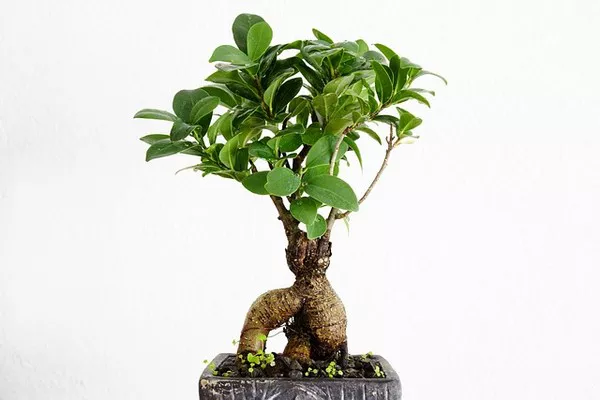Ficus bonsai trees are captivating miniature versions of the beloved ficus tree, prized for their elegant appearance and symbolism in bonsai culture. Originating from tropical and subtropical regions, ficus bonsai trees belong to the Ficus genus, encompassing hundreds of species. These resilient trees are favored by bonsai enthusiasts for their adaptability and ease of care. However, to ensure their health and longevity, it’s crucial to adhere to essential care guidelines to ficus bonsai trees and promptly address any issues that may arise.
Essential Care Guidelines
1. Placement and Sunlight
Proper placement is fundamental to the well-being of your ficus bonsai tree. Place it in a location that receives ample indirect sunlight, preferably near a window facing east or west. Avoid exposing the tree to direct sunlight for extended periods, especially during the scorching afternoon hours, as it can lead to leaf burn. Rotate the bonsai regularly to ensure even exposure to light and prevent the growth of lopsided branches.
2. Watering
Maintaining appropriate moisture levels is vital for the health of your ficus bonsai. Water the tree thoroughly when the topsoil feels slightly dry to the touch, but avoid overwatering, as it can cause root rot. Use room temperature water and ensure proper drainage to prevent waterlogging. During the warmer months, your ficus bonsai may require more frequent watering, while in winter, when growth slows, reduce the watering frequency accordingly.
3. Humidity
Ficus bonsai trees thrive in humid environments akin to their native habitats. To mimic these conditions, provide adequate humidity by misting the foliage regularly with a fine spray of water. Alternatively, place the bonsai on a humidity tray filled with water and pebbles to increase moisture levels around the tree. Avoid placing the bonsai near drafty areas or heating vents, as they can exacerbate dryness.
4. Temperature
Maintain a consistent temperature range for your ficus bonsai tree, ideally between 65°F to 75°F (18°C to 24°C). Avoid exposing the tree to drastic temperature fluctuations or drafts, as they can stress the plant and hinder its growth. During winter, protect the bonsai from cold drafts and ensure it is kept away from heaters to prevent drying out.
5. Soil and Fertilization
Well-draining soil is essential for the health of your ficus bonsai. Use a quality bonsai soil mix that promotes aeration and root development. Repot the bonsai every two to three years to replenish nutrients and prevent the soil from becoming compacted. Fertilize the tree regularly during the growing season with a balanced liquid fertilizer diluted to half strength. Reduce fertilization in winter when the tree is dormant.
6. Pruning and Shaping
Regular pruning is necessary to maintain the desired shape and size of your ficus bonsai tree. Use sharp, sterile pruning shears to trim back excessive growth, remove dead or diseased branches, and encourage branching. Prune with caution, as ficus trees bleed latex sap, which can be irritating to the skin. Shape the bonsai gradually over time, allowing it to recover between pruning sessions.
7. Repotting
Repotting is a crucial aspect of ficus bonsai care, promoting root health and vitality. Repot the tree every two to three years during the spring or early summer months when it is actively growing. Choose a slightly larger pot and trim back a portion of the roots to encourage new growth. Replace the soil with fresh bonsai soil mix and water the tree thoroughly after repotting. Monitor the bonsai closely for signs of stress and adjust care accordingly.
Troubleshooting and Common Problems
Despite your best efforts, ficus bonsai trees may encounter various issues that require prompt attention. Here are some common problems and how to address them:
1. Yellowing Leaves: Yellowing leaves can indicate overwatering, underwatering, or nutrient deficiencies. Adjust watering habits, ensure proper drainage, and fertilize the tree as needed. Trim off any yellowed or diseased foliage to encourage new growth.
2. Leaf Drop: Leaf drop can occur due to stress, environmental changes, or pest infestations. Assess the tree’s surroundings for any potential stressors, such as drafts or improper lighting. Inspect the foliage for signs of pests, such as scale or spider mites, and treat the tree with insecticidal soap if necessary.
3. Root Rot: Root rot is a common issue caused by overwatering or poor drainage. If the soil feels excessively wet or foul-smelling, carefully remove the bonsai from its pot and inspect the roots for signs of rot. Trim away any affected roots and repot the tree in fresh soil, ensuring proper drainage to prevent future rot.
4. Pest Infestations: Ficus bonsai trees are susceptible to various pests, including aphids, mealybugs, and scale insects. Monitor the tree regularly for signs of infestation, such as sticky residue or distorted foliage. Treat the tree with insecticidal soap or neem oil, following the manufacturer’s instructions carefully.
Conclusion
By following these essential care guidelines and promptly addressing any issues that arise, you can ensure the health and vitality of your ficus bonsai tree for years to come. With proper care and attention, your bonsai will thrive, bringing beauty and tranquility to any space.


